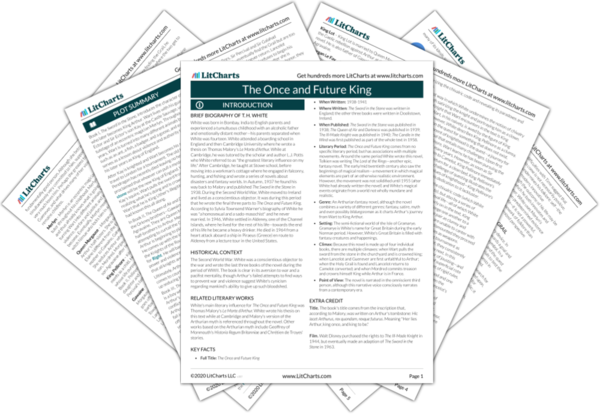Summary
Analysis
Two young boys in medieval England, Wart and Kay, live in the Castle of the Forest Sauvage. Kay is the son of the lord of the castle, Sir Ector. While Wart is an adopted orphan who's real name is Arthur (Kay gave him the nickname Wart). Kay doesn't have a nickname—he is too dignified for one, given that he is Sir Ector's real son and will be a knight one day, whereas Wart will only be his squire.
The novel opens by describing the daily lives of the medieval youths and establishes the complex relationship between Wart and Kay—Kay has given Wart a derogatory nickname, but will not let Wart give him one in return. Kay is very aware of his superior status (being both older and of noble birth) and thus patronizes Wart who only worships Kay unquestioningly.
Themes
Sir Ector has recently gotten rid of their governess (she had a bout of hysterics and was committed to a lunatic asylum) and so is concerned with the boys' education. While sharing some port with Sir Grummore Grummerson —a visiting Knight—the two men decide that the boys need a tutor and agree that they must quest for a new one.
Sir Ector and Sir Grummore Grummerson, although established knights, are ridiculous characters (even Sir Grummore's name is comedic) who act like a 'quest' is both commonplace and a game because here the objective of the quest is finding a tutor rather than seeking some higher truth (what a quest traditionally entails).
Themes
It is July and hay-making season—the July weather of Old England where men turn brown in the sun. Every man, woman and child works in the fields during hay-making, even the boys, and Sir Ector stands atop a cart to supervise. Although Sir Ector mostly hinders the procedure and it is his assistants who make sure everything runs smoothly.
Sir Ector is a bumbling idiot—he is the figure of highest authority but his rule is carried out by those underneath him, as illustrated with the hay-making. We expect Sir Ector to be chivalrous, being an experienced knight, but instead he is satirized.
Themes
One afternoon, the two boys slip away to play and decide to take Cully the Hawk to catch rabbits. They go to the Mews where the hawks are kept. When Cully only glares in response to Kay's call to come, Kay, impatient, grabs him. Wart says nothing. Although he often disagrees with Kay's conduct, Wart doesn't speak up about it because Kay is older than him and Sir Ector's proper son. Besides, Wart worships Kay.
Get the entire The Once and Future King LitChart as a printable PDF.

Walking across the fields, Wart suggests that they not fly Cully as they hadn't correctly roused him. Kay brushes this off. Wart itches to take Cully, but thinks how annoying it would be for Kay to hear the preachings of a younger, inferior boy. Kay threw his arms upwards to make the hawk take off and Cully swooped into the air. The hawk looked down at his masters, angrily—Kay had forced him to take off—and flies off away from the boys, ignoring their calls.
Throughout White's description of this incident, he refers in detail to the peculiarity of medieval pursuits—for example, how there is a specific way of flying a hawk. These details accentuate the reader's alienation from the novel's setting and the feeling of immersion in a strange and comic world.
Themes












